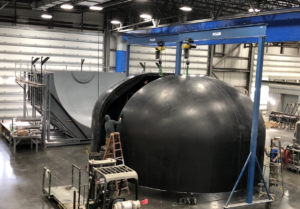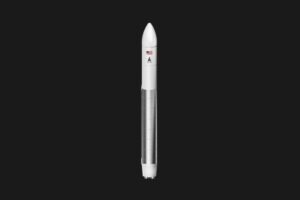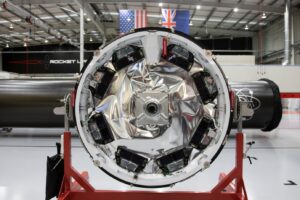
Sierra Space Has Begun Full-Scale LIFE Habitat Testing!
One of the biggest challenges when it comes to creating a Space Station is the size of the segments. Even with modern and next-generation rocket development, fairings are still only so big and limit how big of a module can be launched. This is why Sierra Space has been working on inflatable modules that launch at a reasonable size and then inflate in orbit.
Just days ago, they successfully completed the most significant test yet, putting a full-scale LIFE module through an Ultimate Burst Pressure Test (UBP). This is one of the final steps before they eventually send these test units to space, and begin testing them on orbit. Here I will go more in-depth into the recent test, the exact results, what to expect in the coming months, and more.
Full-Scale Burst Test

For years now Sierra Space has been testing the Large Integrated Flexible Environment (LIFE) in a host of different ways. In the past, we saw smaller scaled-down test articles complete the same UBP test to ensure the design was safe. Here they continue to increase the pressure until the habitat bursts, providing valuable data on its strength and breaking point. Other tests included long-duration pressure tests where they leave the pressure shell pressurized for an extended period of time. Up until recently, all of these prior milestones were on much smaller test articles.
Just a few days, however, the company tweeted saying, “Sierra Space has achieved a major milestone in the development of the first commercial #space station. The first Ultimate Burst Pressure test of our full-scale LIFE structure at @NASA_Marshall exceeded #NASA’s recommended x4 safety levels by 27%.” In a statement they said, “The full-scale unit in this test reached 77 psi before it burst, which well exceeds (+27%) NASA’s recommended level of 60.8 psi (maximum operating pressure of 15.2 psi multiplied by a safety factor of four).
In the video, as it bursts, you can see the fabric stretch out on the left side before the entire shell gives way and explodes from the pressure. In order to create a structure that can be inflated but is also immensely strong, they had to use a unique combination of materials. First, you have the restraint layer for LIFE, constructed of high-strength “softgoods” materials, which are sewn and woven fabrics – primarily Vectran – that become rigid structures when pressurized. They point out that under normal operating pressure, the Vectran softgoods materials become 5x stronger than steel, exceeding station lifetime performance safety factors. The restraint layer is complemented by a bladder allowing controlled inflation and pressurization to ultimate burst pressure test failure. Together this creates a structure strong enough to withstand micrometeoroid impacts and other projectiles.
They highlighted that this test specifically focused on the LIFE habitat pressure shell (the restraint layer). In this case, the company, working with its exclusive softgoods technology partner ILC Dover, has designed and tested Vectran straps at the component and sub-scale levels prior to this full-scale test.
In the future, the LIFE Habitat is intended to be packed inside a standard five-meter rocket fairing and inflated to the size of a three-story apartment building on orbit. Sierra Space is quoted saying, “In just three launches, the modular LIFE units can create a living and working environment in space that is larger, volume-wise than the entire International Space Station (ISS). In the coming years, the company will iterate on larger designs. A 1400-cubic-meter version, packaged inside a seven-meter rocket fairing, for example, would surpass the size of the ISS in a single launch. In other words, assuming this initial LIFE module works as intended, they will continue to iterate and make it even larger. This process starts with LIFE 1.0 and goes up to LIFE 3.0, the biggest variant.
With this test complete, the question becomes what exactly is next for the company and this hardware. In another quote, Sierra Space says, “Building upon this successful test, Sierra Space will embark on an aggressive 2024 testing campaign at both sub- and full-scale, including a series of UBP tests in tandem with early-stage development of the primary Atmospheric Barrier and Micrometeoroid Orbital Debris (MMOD) layers.” Something we can look forward to seeing in the coming months.
Future In Orbit

By now, there already are a few ambitious plans for these modules in the future. The most notable is Orbital Reef, a commercial space station led by Blue Origin and Sierra Space. For that specific station, Sierra Space is expected to provide multiple LIFE modules which will likely make up the majority of the station’s pressurized volume. Recently there was some confusion regarding the future of Orbital Reef and the partnership between Sierra Space and Blue Origin. The two companies have since cleared this up and commented that they are committed to the project and each other.
In theory, they would use New Glenn to send up both the main hard structure modules as well as the uninflated LIFE Habitats. Over time they would connect and inflate these modules until Orbital Reef station began to take shape. All this being said, despite the recent successful test, Orbital Reef is not scheduled to be operational until much later in this decade.
As partially mentioned before, LIFE plans to get much bigger over time. This LIFE 1.0 model has 285 cubic meters of volume. The 2.0 model will have 600 cubic meters of volume and the 3.0 variant will have an impressive 1440 cubic meters of volume. Sierra Space lists that the 3.0 variant and its extra space will provide increased crew capabilities, volume allocations, and even layout changes.
The standard LIFE habitat is currently being designed to support four crew members living and working on long-duration missions, such as those to Mars. Sierra Space highlights however that it comfortably houses six for missions in LEO, but can accommodate 12 crew for shorter periods of time such as those during which crew members transition. Because of its modular nature, additional habitats can be joined to each other to accommodate more crew, or for a variety of other purposes. The only main solid and noninflatable component is the vestibule which would be used to connect to other segments and leave or enter the habitat.
Focusing back on the first full-scale test, they point out that it was performed with support from NASA via a Reimbursable Space Act Agreement in which NASA’s Marshall Space Flight Center provides services to Sierra Space in support of its exploration and commercial Low Earth Orbit technology development and risk reduction activities. This test occurred in Huntsville, Ala., on Redstone Arsenal adjacent to the historic Saturn 1/1B test stand. After the test was completed, Shawn Buckley, Senior Director of Engineering and Chief Technologist of EarthSpace Systems said, “Over the past two years, our team has worked tirelessly to reach this point. Working with our key suppliers and strategic partners, Sierra Space has guided our collaborative effort and reached new heights with this latest UBP test. We have assembled the expertise and knowledge that is required to propel this amazing technology to the next steps – Low Earth Orbit and beyond” he said.
Sierra Space believes that one of the most remarkable features of the LIFE habitat is its adaptability to accommodate a range of businesses, from in-space semiconductor manufacturing to pharmaceutical microgravity research. The habitat leverages the unique conditions of zero gravity, offering an optimal environment for experiments and processes that benefit from this distinct microgravity setting. With substantial volume, power, and data capabilities, they are confident that the habitat is primed for extended human habitation, both for low-Earth Orbit (LEO) missions and for the demanding challenges of long-duration voyages, such as Lunar and Mars surface habitation.
Starting years ago, Sierra Space set up a full-size mockup of the habitat including interior furnishing with various equipment that you would expect on an actual mission. Looking at an image of the second floor, you can see a crew work area with some computers and shelving. The floor and ceiling are also secured in place likely using sectional pieces that can be launched in a compact format for assembly in space. While the main habitat is inflatable, practically everything you put in it is not. This means you would need very space-efficient pieces of equipment and necessary structures to fill the space with. In another image, it shows off the company’s Astro garden near the access hatch. Finally, moving up to the third floor, a look at the crew living area and galley table shows off the impressive space available.
Once in space, all of the air and water required to survive would be delivered by logistics carriers to the habitat, where it’s then stored until needed. The LIFE habitat has life support systems that regulate the air to maintain proper pressure, temperature, humidity, and oxygen levels. These life support systems recycle some of the air and water that is used to reduce the amount that has to be delivered to the habitat. It can even launch on the Space Launch System (SLS) since it expands only after it is on-orbit, making it easier and less expensive to transport. Once fully inflated, work would be done to outfit it with everything listed prior making it a relatively massive habitat in space.
Conclusion
Sierra Space just completed the most significant LIFE Habitat test in the technology history. With this step complete, they plan to ramp up testing with both sub and full-scale habitats until the system is ready to head to space. We will have to wait and see how it progresses and the impact it has on the space industry.



